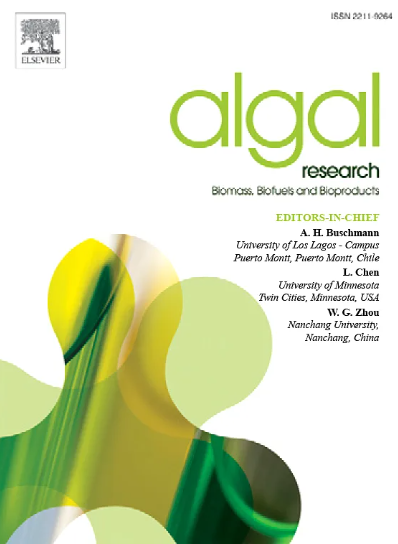不同食品级蛋白质提取方法对螺旋藻蛋白质组谱和潜在过敏性的影响
IF 4.5
2区 生物学
Q1 BIOTECHNOLOGY & APPLIED MICROBIOLOGY
Algal Research-Biomass Biofuels and Bioproducts
Pub Date : 2024-10-21
DOI:10.1016/j.algal.2024.103765
引用次数: 0
摘要
目前已报道了多种用于藻类细胞破碎和蛋白质提取的优化方法,但缺乏有关提取蛋白质的蛋白质组特征的信息;因此,对蛋白质概况进行系统的验证,以找到潜在的可利用蛋白质,同时最大限度地降低过敏风险,是有利可图的。本研究采用高剪切匀浆法和 pH 值偏移法进行水提取蛋白后,开发了一种方法来彻底研究 A. platensis 的蛋白质组特征。采用液相色谱-串联质谱法,利用数据依赖性蛋白质组分析评估了四种蛋白质提取方法获得的蛋白质组。共鉴定出 699 个蛋白质;然而,每种提取方法都鉴定出了独特的蛋白质。使用高剪切匀浆和酸性 pH 组合提取的蛋白质数量最多。对蛋白质丰度的评估显示,与通过中性或碱性 pH 处理分离出来的蛋白质相比,pH 值为 2 的蛋白质有明显的区别。所采用的提取方法影响了蛋白质的硅学计算理化性质。利用 AllerCatPro 数据库,检测到了 12 种推测的致敏蛋白质,其中最主要的与 C-花青素 beta 亚基(P72508)有关。这项研究表明,提取方法会影响所获蛋白质的检测、理化性质和潜在过敏性。因此,在将新型蛋白质用作功能食品之前,提取方法必须考虑到这些方面。本文章由计算机程序翻译,如有差异,请以英文原文为准。
Impact of different food-grade protein extraction methods on the proteomic profile and potential allergenicity of Spirulina (Arthrospira platensis)
Various optimized methods for cell disintegration and protein extraction of algae have been reported, but there is a lack of information regarding the proteomic characterization of the extracted proteins; thus, systematic verification of the protein profiles to find potentially exploitable proteins, while minimizing allergenicity risks, is profitable. The method described in this study was developed to thoroughly investigate the proteome characterization of A. platensis following aqueous protein extraction by high-shear homogenization and pH shift. Liquid chromatography-tandem mass spectrometry was applied to assess the proteome obtained from four protein extraction methods using data-dependent proteome analysis. Overall, 699 proteins were identified; however, each extraction method identified unique proteins. The maximum number of exclusive proteins was observed using a combination of high-shear homogenization and acidic pH. The evaluation of protein abundance revealed a clear distinction between proteins isolated from pH 2 treatment compared to those obtained via neutral or basic pH treatment. The applied extraction methods affected the in silico computed physicochemical properties of the proteins. Using the AllerCatPro database, 12 putative allergenic proteins were detected, the most predominant of which were related to the C-phycocyanin beta subunit (P72508). This study demonstrated that extraction methods affect the detection, physicochemical properties, and potential allergenicity of the obtained proteins. Hence, the extraction methods used to obtain novel proteins must consider these aspects before using them as functional foods.
求助全文
通过发布文献求助,成功后即可免费获取论文全文。
去求助
来源期刊

Algal Research-Biomass Biofuels and Bioproducts
BIOTECHNOLOGY & APPLIED MICROBIOLOGY-
CiteScore
9.40
自引率
7.80%
发文量
332
期刊介绍:
Algal Research is an international phycology journal covering all areas of emerging technologies in algae biology, biomass production, cultivation, harvesting, extraction, bioproducts, biorefinery, engineering, and econometrics. Algae is defined to include cyanobacteria, microalgae, and protists and symbionts of interest in biotechnology. The journal publishes original research and reviews for the following scope: algal biology, including but not exclusive to: phylogeny, biodiversity, molecular traits, metabolic regulation, and genetic engineering, algal cultivation, e.g. phototrophic systems, heterotrophic systems, and mixotrophic systems, algal harvesting and extraction systems, biotechnology to convert algal biomass and components into biofuels and bioproducts, e.g., nutraceuticals, pharmaceuticals, animal feed, plastics, etc. algal products and their economic assessment
 求助内容:
求助内容: 应助结果提醒方式:
应助结果提醒方式:


